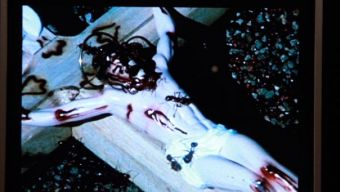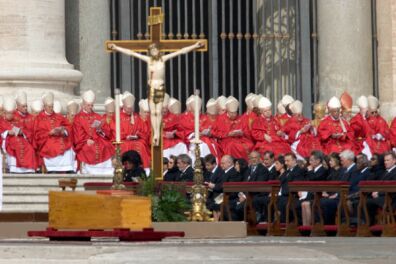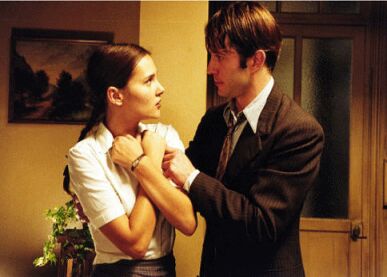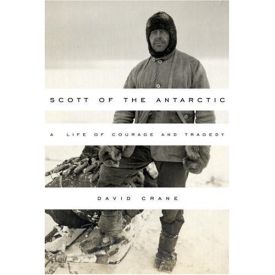Taking “Offense”
From The American SpectatorAnother month, another media hurricane of “controversy” in “the arts.” Forgive my use of quotation marks in the previous sentence, but in our postmodern world, it’s hard to avoid them if you want to be precise in your meaning. More about that in a moment. For now, let’s just notice that neither controversy nor the arts can be taken at face value these days. I hope it will not be thought unduly cynical of me to notice a certain sameness to the controversies that regularly pop up in the arts world. Someone produces an image suggesting contempt and disrespect towards a sacred object or symbol — as it might be, a video tape of ants crawling over a crucifix — and those for whom the object or symbol remains sacrosanct howl in protest. The cultural institutions who have sponsored the image then take fright and withdraw it, whereupon the cultural left in its turn howls in protest — at “censorship.” There is a kind of ritual quality to all this, and to the media’s coverage of it, which has the effect of making an artistic celebrity out of whatever conceptual artist has had the idea of this particular act of desecration — unless, of course, his target be the Prophet Muhammed — peace be upon him — in which case he will avoid celebrity for fear of being murdered by the kind of fanatics who know nothing of quotation marks.
It is only in this wise that the arts ever come to most people’s attention nowadays, which is why we need the quotation marks for “the arts” as well as the “controversies” they so routinely generate. Perhaps I am unfair to David Wojnarowicz, he of the ant-infested crucifix, since he died of AIDS eighteen years ago and controversy over his work, briefly displayed in an exhibition titled “Hide/Seek” at the National Portrait Gallery of the Smithsonian Museum, has only just blown up. Yet even in his lifetime, the path to fame and fortune pioneered by André Serrano or Robert Mapplethorpe was well-established. It’s hardly surprising that poor Mr Wojnarowicz’s work lay unnoticed for decades among the welter of such stuff produced by our conceptual revolutionaries before being tapped by the National Portrait Gallery and the Catholic League too late to do him any good.
As Eric Felten of The Wall Street Journal pointed out there was a curious feature of the outrage against the outrage. I know this is hard to follow, but bear with me. The Catholic League got outraged first and then, when the Smithsonian took fright and pulled the offending video, the progressives and the art establishment got outraged. Most notable among the second wave of the outraged was Blake Gopnik of The Washington Post who had reviewed the exhibition in glowing terms a few weeks earlier and found the scene of the ant-y crucifix to be “such an inconsequential part of the total video that neither I nor anyone I’ve spoken to who saw the work remembered it at all.” As Mr Felten wrote, “So tired, so shopworn, are the art world’s provocations, they go unnoticed even by their advocates.” And yet, once it was pointed out to them that the thing had given offense, they treated it as if it were the linch-pin of the whole exhibition.
You’ve got to wonder. If the purpose of the artist is to shock, then why does he or his apologists complain when people are shocked and attempt to “censor” him? Isn’t that a sign of his success? Isn’t that what he was going for? The affectation of Blake Gopnik or Frank Rich of being shocked that conservatives are shocked seems at least as pro forma and therefore a candidate for the quotation marks as the initial offense. I wonder if this is the result of a sort of shame-inversion. That is, the shockers choose to take offense at the fact that others have been offended by them because it allows them to shift the shame of their own behavior onto those who are shocked by it. Aren’t you ashamed to be shocked? they are asking the shockees. Aren’t you feeling guilty yet for the offense your being offended has given to the poor persecuted and, by the way, AIDS-afflicted gay people who have offended you?
For both sides, the ostensible cause of the shock, is a stand-in for a lingering controversy (without quotation marks) about homosexuality. On the conservative side, the new social norms will no longer allow them to be shocked by open gayness, which is how enough Republicans were peeled off to get the repeal of Don’t Ask, Don’t Tell passed in the lame-duck session of Congress. As a result, they have to find something else to be offended at — which is not meant to imply that they are not really offended. On the progressive side, their taking offense at having given offense is a form of utopianism: an attempt to insist on their fantasy of guilt-free sex by shifting the guilt onto others, namely those who are so shameless about their non-progressivism as to advocate the retention of guilt.
Yet guilt remains inseparable from real sexual relationships and probably even from same-sex ones. Under the different name of “transgressiveness” such guilt is recognized — and celebrated — by the progressives themselves in exhibitions like “Hide/Seek” without any hint of awareness of the absurdity of enshrining the transgressive and unofficial at the center of official culture in an institution called the National Portrait Gallery. The point of the artistic sub-cultural encoding that the exhibition celebrates is to obscure, not reveal, and when you make an exhibition, in every sense, of what has been hidden, it isn’t hidden anymore. Duh! Similarly, in becoming out and proud, the nature of gayness itself is changed from what it is everywhere in the Smithsonian show — that is something thrillingly secret and wicked — to something as banal and ordinary and untransgressive as, well, marriage.
The explication or unfolding of hidden gayness is repeated, too, in the curators’ explications of the works of art that have encoded it — I suppose because the audience for the arts has become amateurish and lazy, more politically than aesthetically motivated. It expects the artist to act as his own critic and not only create the art but tell you what it means. Take another example from the “Hide/Seek” show by Felix Gonzalez-Torres titled “‘Untitled’ (Portrait of Ross in L.A.)” which is a tribute to a now-dead gay lover.. It consists of a pile of brightly wrapped candies in a corner of the museum with the following explanation on a card displayed alongside it:
Viewers are invited to take away a candy until the mound gradually disappears; it is then replenished, and the cycle of life and death continues. While Gonzalez-Torres wanted the viewer/participant to partake of the sweetness of his own relationship with Ross, the candy spill also works as an act of communion. More darkly, the steadily diminishing pile of cheerfully wrapped candies shows the dissolution of the gay community as society ignored the AIDS epidemic. In the moment that the candy dissolves in the viewer’s mouth, the participant also receives a shock of recognition at his or her complicity in Ross’s demise.
Gosh! You get art, critical appreciation, guilt and candy all at once. What’s not to like? But the best thing about it, so far as I was concerned is the prominently displayed notice near to hand: “Please Note. Eating candy from this exhibition may present a choking hazard.” Obviously, the Smithsonian wouldn’t want to be guilty of complicity in your demise as well. In the exhibition catalogue, the card’s explanation is slightly expanded to note that the act of communion is “a partaking of the body with deep resonance in Gonzalez-Torres’s own Catholicism.” Guilty again! Those darn Catholics themselves taught him the trick!
The same could be said, perhaps, about postmodernism generally — which, like the “Hide/Seek” exhibition, has its origins in the idea of “camp” as first outlined by the late Susan Sontag (a photograph of whom in youth and an erotic pose decorates the “Contents” page of the exhibition catalogue). In her “Notes on ‘Camp’” — a title already liberal with quotation marks — she wrote that “Camp sees everything in quotation marks. It’s not a lamp, but a ‘lamp’; not a woman, but a ‘woman.’ To perceive Camp in objects and persons is to understand Being-as-Playing-a-Role. It is the farthest extension, in sensibility, of the metaphor of life as theater.” The same could be said about “Hide/Seek” which is really not so much about the gay world as it is about the birth of our own world, the world that lives between quotation marks. And just as the specialized taste for camp of which Miss Sontag wrote all those years ago has now driven out all other sorts of taste, so the secretly sexualized world of the gay-subculture of the 1920s and ‘30s has become the openly sexualized world of today. But the thrill of sexual transgressiveness as documented in “Hide/Seek” is gone.
Discover more from James Bowman
Subscribe to get the latest posts to your email.







